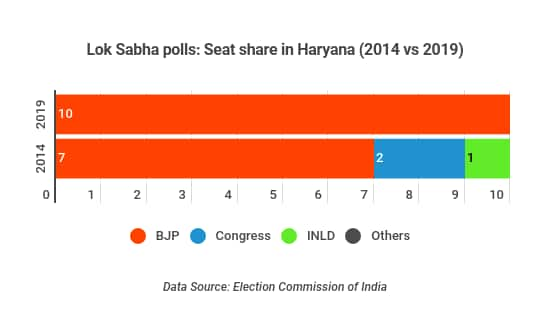


The National Democratic Alliance (NDA) on May 23 registered a massive victory in the 2019 Lok Sabha election, winning over 350 seats to retain power. The Bharatiya Janata Party (BJP) itself won over 300 seats — its highest tally ever.
Even before Narendra Modi is sworn in as the Prime Minister for the second term on May 30, the BJP has already begun preparations for the imminent Legislative Assembly elections in Haryana, Jharkhand and Maharashtra. State elections are also expected to be held in Jammu and Kashmir, which is currently under President’s Rule.
The three states, currently governed by BJP and its allies, are expected to head for polls in October this year upon completion of its Assembly terms.
The Lok Sabha election results are expected to have a huge bearing on the state polls just as they did in 2014. In 2014, the BJP had managed to win the three states riding on the ‘Modi wave’.
How NDA crushed the Opposition in these states
In Maharashtra, the BJP and its ally Shiv Sena won 23 and 18 seats, respectively. The Indian National Congress and Sharad Pawar’s Nationalist Congress Party (NCP) won one and four seats, respectively. All India Majlis-e-Ittehad-ul-Muslimeen (AIMIM) managed to win Aurangabad while Congress-supported Independent candidate Navnit Ravi Rana won the Amravati. Maharashtra has a total of 48 parliamentary constituencies.
The NDA also increased its vote share at the expense of the UPA.
 Maharashtra
Maharashtra
Data analysis suggests that Prakash Ambedkar’s Vanchit Bahujan Aghadi (VBA) managed to pick up a significant vote share in some crucial seats. This hurt the UPA’s chances. UPA had unsuccessfully tried to get VBA on board the alliance. Had the alliance materialised, the Opposition would have won seven more seats.
Also read: Opinion | Why Maharashtra’s politicians are still in campaign mode
The saffron party swept the state of Haryana, winning all of the 10 seats there. BJP’s vote share significantly increased as compared to 2014. A closer look at the numbers shows that the BJP’s sweep was not at the expense of the Congress, but at the expense of the Indian National Lok Dal (INLD).
Here, even if the Jannayak Janta Party (JJP) had allied with the Congress, the Opposition could have only won the Rohtak seat.
 Haryana
Haryana
In Jharkhand, the NDA won 12 out of the state’s 14 seats. The BJP won 11 while the All Jharkhand Students Union (AJSU) won one. Congress and its ally Jharkhand Mukti Morcha (JMM) managed to win one each.
 Jharkhand
Jharkhand
How the alliances stack up
As things stand, the Congress and the NCP are likely to remain in an alliance for the state polls. It remains to be seen if the UPA tries to get the VBA on board, fearing a split Opposition voter base. The BJP and the Shiv Sena had made it clear in the run-up to the general election that they will contest together in the Vidhan Sabha polls too. They are likely to have the continued support of the Republican Party of India (Athawale) (RPI-A).
In Haryana, Congress and the JJP had fought separately. Here too, it remains unclear if they would have a rethink on an alliance.
Congress is expected to remain in an alliance with JMM and the Jharkhand Vikas Morcha (Prajatantrik) (JVM) in Jharkhand.
Also read: What the result means for BJP's allies
What could change going forward?
NDA’s performance in Chhattisgarh, Madhya Pradesh and Rajasthan has once again demonstrated that voting pattern differs at different levels — state and the Centre. Congress had wrested these states from the BJP in December 2018.
Therefore, local anti-incumbency and regional factors and issues could impact what will be on voters’ mind in October.
Also read: It's a bumpy road ahead for regional parties
Popularity levels of various chief ministers and the prime minister have been in different bands, data from opinion surveys suggest. This means, people could vote differently when PM Modi is not on the ballot.
In 2014, when the BJP formed governments in these three states, it was not only riding the ‘Modi wave’, but also challenging the incumbent. Now, the party is defending. Earlier, Moneycontrol had analysed how the BJP’s election machinery had been better while challenging, than defending in the last five years.
Discover the latest Business News, Sensex, and Nifty updates. Obtain Personal Finance insights, tax queries, and expert opinions on Moneycontrol or download the Moneycontrol App to stay updated!
Find the best of Al News in one place, specially curated for you every weekend.
Stay on top of the latest tech trends and biggest startup news.